Overpopulation Environmental aspects Term in general. History
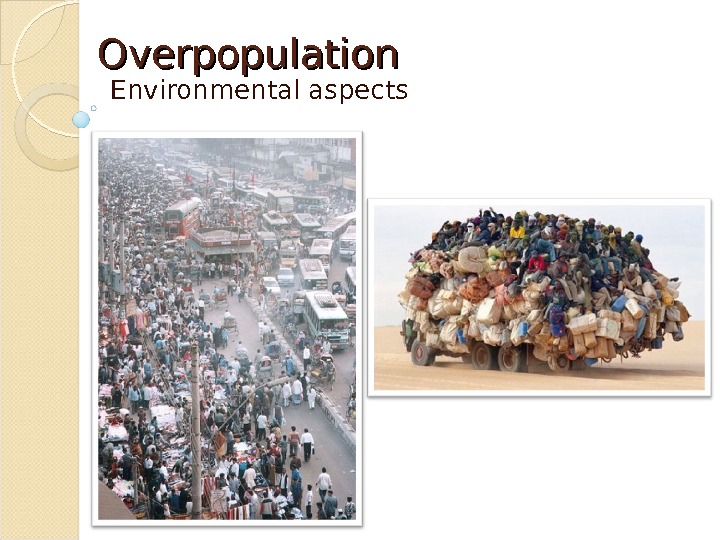
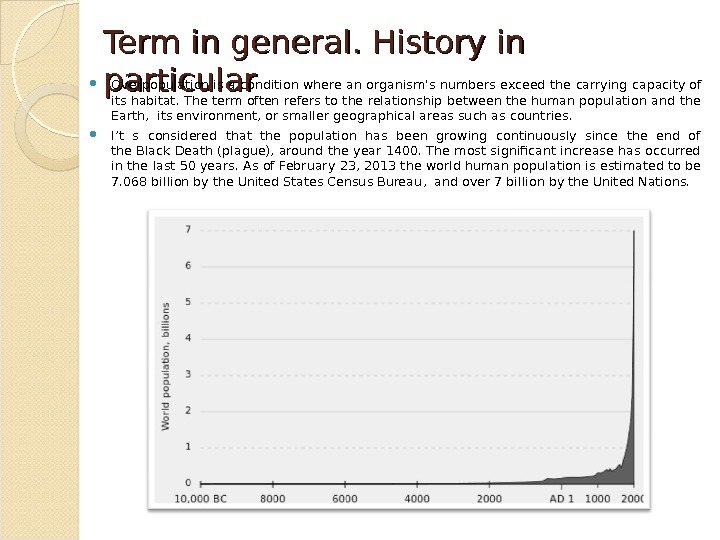

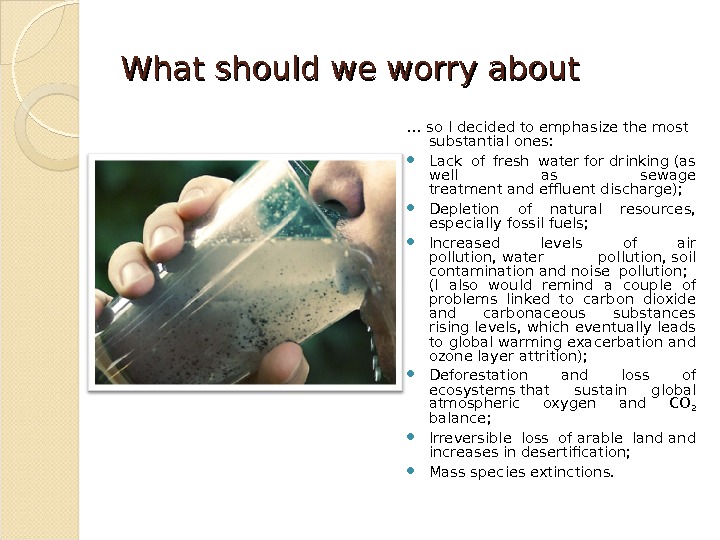
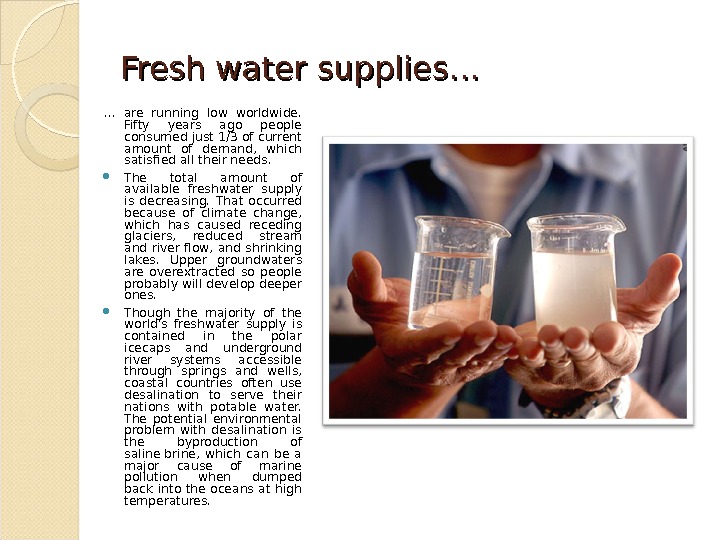
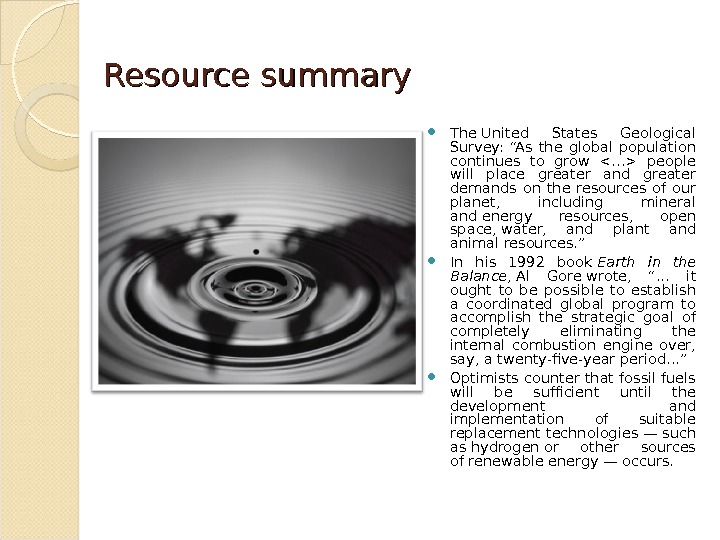
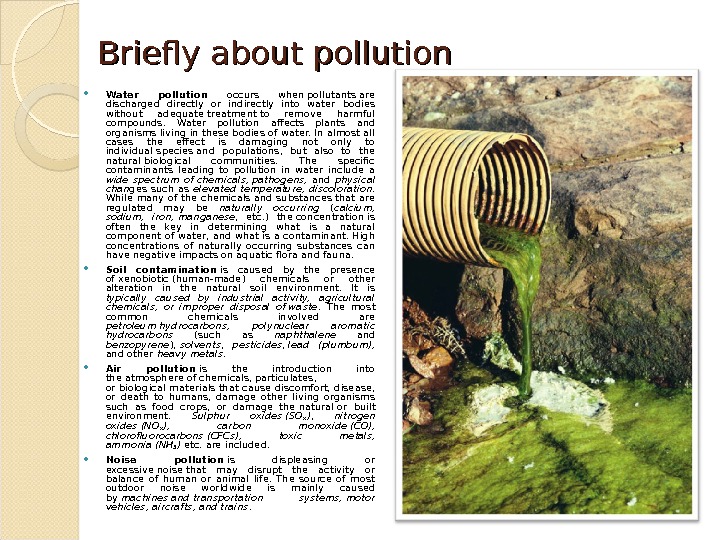
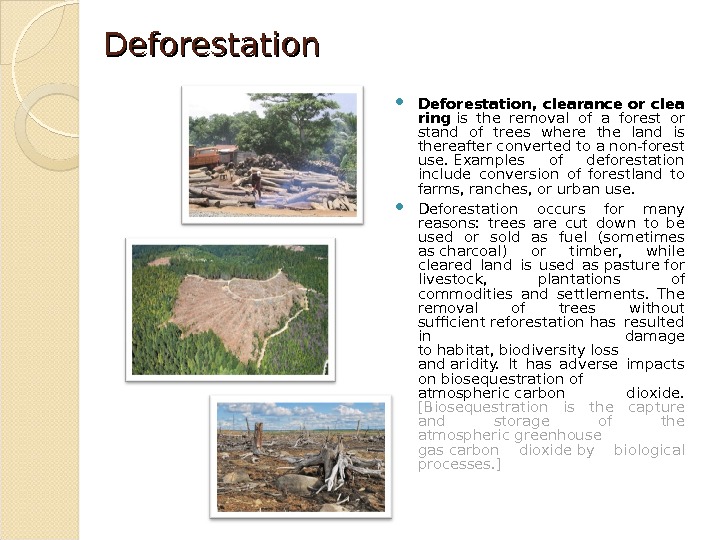
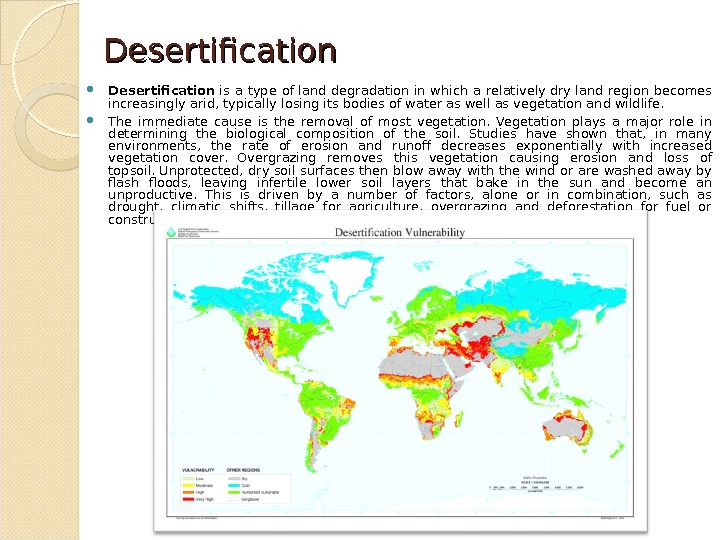
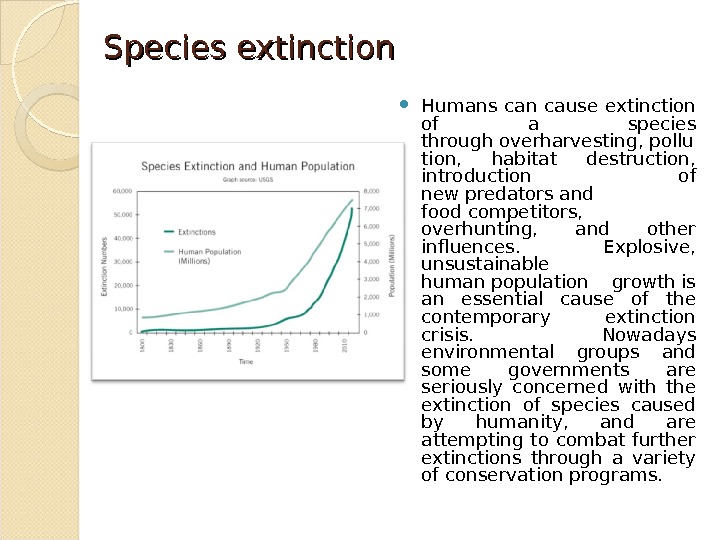
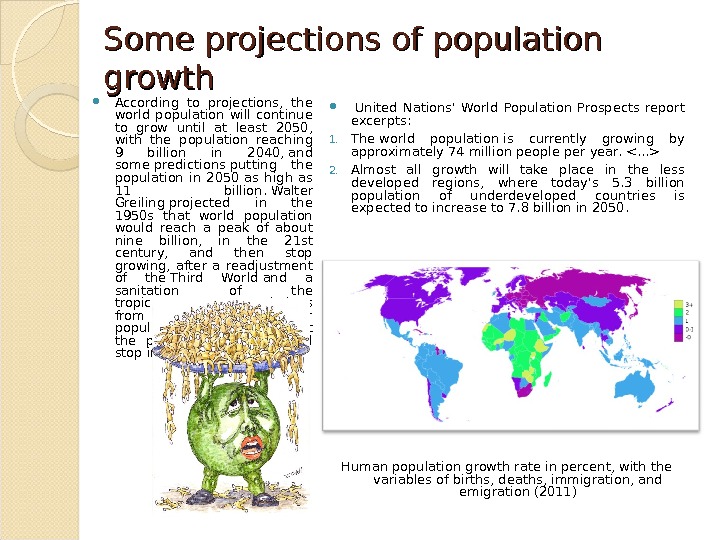
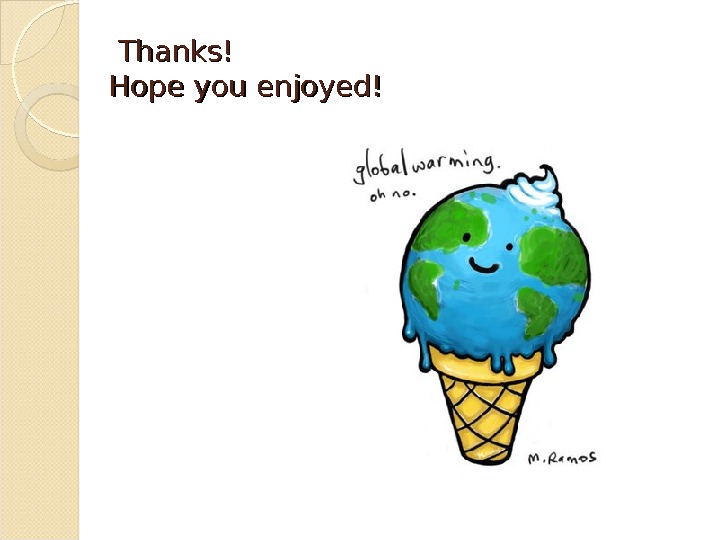
overpopulation_environment.ppt
- Размер: 10.1 Mегабайта
- Количество слайдов: 12
Описание презентации Overpopulation Environmental aspects Term in general. History по слайдам
 Overpopulation Environmental aspects
Overpopulation Environmental aspects
 Term in general. History in particular Overpopulationis a condition where anorganism’s numbers exceed the carrying capacityof itshabitat. The term often refers to the relationship between thehuman population and the Earth , its environment, or smaller geographical areas such as countries. I’t s considered that the population has been growing continuously since the end of the. Black Death (plague), around the year 1400. The most significant increase has occurred in the last 50 years. As of February 23 , 2013 the world human population is estimated to be 7. 068 billionby the. United States Census Bureau , and over 7 billion by the United Nations.
Term in general. History in particular Overpopulationis a condition where anorganism’s numbers exceed the carrying capacityof itshabitat. The term often refers to the relationship between thehuman population and the Earth , its environment, or smaller geographical areas such as countries. I’t s considered that the population has been growing continuously since the end of the. Black Death (plague), around the year 1400. The most significant increase has occurred in the last 50 years. As of February 23 , 2013 the world human population is estimated to be 7. 068 billionby the. United States Census Bureau , and over 7 billion by the United Nations.
 Competent opinion The recent rapid increase in human population over the past three centuries has raised concerns that the planet may not be able to sustain present or larger numbers of inhabitants. The. International Academy Panel Statement on Population Growth has stated that many environmental problems are aggravated by the population expansion…
Competent opinion The recent rapid increase in human population over the past three centuries has raised concerns that the planet may not be able to sustain present or larger numbers of inhabitants. The. International Academy Panel Statement on Population Growth has stated that many environmental problems are aggravated by the population expansion…
 What should we worry about … so I decided to emphasize the most substantial ones: Lack of fresh waterfordrinking(as well as sewage treatmentandeffluentdischarge); Depletion of natural resources, especiallyfossil fuels; Increased levels of air pollution, water pollution, soil contaminationandnoise pollution; (I also would remind a couple of problems linked to carbon dioxide and carbonaceous substances rising levels, which eventually leads to global warming exacerbation and ozone layer attrition); Deforestation and loss of ecosystemsthat sustain global atmospheric oxygen and CO 2 balance; Irreversible loss ofarable landand increases indesertification; Mass species extinctions.
What should we worry about … so I decided to emphasize the most substantial ones: Lack of fresh waterfordrinking(as well as sewage treatmentandeffluentdischarge); Depletion of natural resources, especiallyfossil fuels; Increased levels of air pollution, water pollution, soil contaminationandnoise pollution; (I also would remind a couple of problems linked to carbon dioxide and carbonaceous substances rising levels, which eventually leads to global warming exacerbation and ozone layer attrition); Deforestation and loss of ecosystemsthat sustain global atmospheric oxygen and CO 2 balance; Irreversible loss ofarable landand increases indesertification; Mass species extinctions.
 Fresh water supplies… … are running low worldwide. Fifty years ago people consumed just 1/3 of current amount of demand, which satisfied all their needs. The total amount of available freshwater supply is decreasing. That occurred because of climate change, which has caused receding glaciers, reduced stream and river flow, and shrinking lakes. Upper groundwaters are overextracted so people probably will develop deeper ones. Though the majority of the world’s freshwater supply is contained in the polar icecaps and underground river systems accessible through springs and wells, coastal countries often use desalination to serve their nations with potable water. The potential environmental problem with desalination is the byproduction of salinebrine, which can be a major cause of marine pollution when dumped back into the oceans at high temperatures.
Fresh water supplies… … are running low worldwide. Fifty years ago people consumed just 1/3 of current amount of demand, which satisfied all their needs. The total amount of available freshwater supply is decreasing. That occurred because of climate change, which has caused receding glaciers, reduced stream and river flow, and shrinking lakes. Upper groundwaters are overextracted so people probably will develop deeper ones. Though the majority of the world’s freshwater supply is contained in the polar icecaps and underground river systems accessible through springs and wells, coastal countries often use desalination to serve their nations with potable water. The potential environmental problem with desalination is the byproduction of salinebrine, which can be a major cause of marine pollution when dumped back into the oceans at high temperatures.
 Resource summary The. United States Geological Survey: “As the global population continues to grow people will place greater and greater demands on the resources of our planet, including mineral andenergy resources, open space, water, and plant and animal resources. ” In his 1992 book Earth in the Balance , Al Gorewrote, “. . . it ought to be possible to establish a coordinated global program to accomplish the strategic goal of completely eliminating the internal combustion engine over, say, a twenty-five-year period. . . ” Optimists counter that fossil fuels will be sufficient until the development and implementation of suitable replacement technologies — such ashydrogenor other sources ofrenewable energy — occurs.
Resource summary The. United States Geological Survey: “As the global population continues to grow people will place greater and greater demands on the resources of our planet, including mineral andenergy resources, open space, water, and plant and animal resources. ” In his 1992 book Earth in the Balance , Al Gorewrote, “. . . it ought to be possible to establish a coordinated global program to accomplish the strategic goal of completely eliminating the internal combustion engine over, say, a twenty-five-year period. . . ” Optimists counter that fossil fuels will be sufficient until the development and implementation of suitable replacement technologies — such ashydrogenor other sources ofrenewable energy — occurs.
 Briefly about pollution Water pollution occurs whenpollutantsare discharged directly or indirectly into water bodies without adequatetreatmentto remove harmful compounds. Water pollution affects plants and organisms living in thesebodies of water. In almost all cases the effect is damaging not only to individualspeciesand populations, but also to the naturalbiological communities. The specific contaminants leading to pollution in water include a wide spectrum ofchemicals, pathogens, and physical chan ges such as elevated temperature, discoloration. While many of the chemicals and substances that are regulated may be naturally occurring ( calcium, sodium, iron, manganese , etc. ) theconcentrationis often the key in determining what is a natural component of water, and what is a contaminant. High concentrations of naturally occurring substances can have negative impacts on aquatic flora and fauna. Soil contamination is caused by the presence ofxenobiotic(human-made) chemicals or other alteration in the natural soil environment. It is typically caused by industrial activity, agricultural chemicals, or improper disposal ofwaste. The most common chemicals involved are petroleumhydrocarbons, polynuclear aromatic hydrocarbons (such as naphthalene and benzopyrene ), solvents , pesticides , lead (plumbum), and other heavy metals. Air pollution is the introduction into theatmosphereofchemicals, particulates, orbiological materialsthat cause discomfort, disease, or death to humans, damage other living organisms such as food crops, or damage thenaturalor built environment. Sulphur oxides(SO x ) , nitrogen oxides(NO x ) , carbon monoxide(CO) , chlorofluorocarbons(CFCs) , toxic metals, ammonia(NH 3 ) etc. are included. Noise pollution is displeasing or excessivenoisethat may disrupt the activity or balance of human or animal life. The source of most outdoor noise worldwide is mainly caused by machinesandtransportation systems, motor vehicles, aircrafts, andtrains.
Briefly about pollution Water pollution occurs whenpollutantsare discharged directly or indirectly into water bodies without adequatetreatmentto remove harmful compounds. Water pollution affects plants and organisms living in thesebodies of water. In almost all cases the effect is damaging not only to individualspeciesand populations, but also to the naturalbiological communities. The specific contaminants leading to pollution in water include a wide spectrum ofchemicals, pathogens, and physical chan ges such as elevated temperature, discoloration. While many of the chemicals and substances that are regulated may be naturally occurring ( calcium, sodium, iron, manganese , etc. ) theconcentrationis often the key in determining what is a natural component of water, and what is a contaminant. High concentrations of naturally occurring substances can have negative impacts on aquatic flora and fauna. Soil contamination is caused by the presence ofxenobiotic(human-made) chemicals or other alteration in the natural soil environment. It is typically caused by industrial activity, agricultural chemicals, or improper disposal ofwaste. The most common chemicals involved are petroleumhydrocarbons, polynuclear aromatic hydrocarbons (such as naphthalene and benzopyrene ), solvents , pesticides , lead (plumbum), and other heavy metals. Air pollution is the introduction into theatmosphereofchemicals, particulates, orbiological materialsthat cause discomfort, disease, or death to humans, damage other living organisms such as food crops, or damage thenaturalor built environment. Sulphur oxides(SO x ) , nitrogen oxides(NO x ) , carbon monoxide(CO) , chlorofluorocarbons(CFCs) , toxic metals, ammonia(NH 3 ) etc. are included. Noise pollution is displeasing or excessivenoisethat may disrupt the activity or balance of human or animal life. The source of most outdoor noise worldwide is mainly caused by machinesandtransportation systems, motor vehicles, aircrafts, andtrains.
 Deforestation, clearanceorclea ring is the removal of a forest or stand of trees where the land is thereafter converted to a non-forest use. Examples of deforestation include conversion of forestland to farms, ranches, or urban use. Deforestation occurs for many reasons: trees are cut down to be used or sold as fuel (sometimes ascharcoal) or timber, while cleared land is used aspasturefor livestock, plantations of commodities and settlements. The removal of trees without sufficientreforestationhas resulted in damage tohabitat, biodiversityloss andaridity. It has adverse impacts onbiosequestrationof atmosphericcarbon dioxide. [Biosequestration is the capture and storage of the atmosphericgreenhouse gascarbon dioxideby biological processes. ]
Deforestation, clearanceorclea ring is the removal of a forest or stand of trees where the land is thereafter converted to a non-forest use. Examples of deforestation include conversion of forestland to farms, ranches, or urban use. Deforestation occurs for many reasons: trees are cut down to be used or sold as fuel (sometimes ascharcoal) or timber, while cleared land is used aspasturefor livestock, plantations of commodities and settlements. The removal of trees without sufficientreforestationhas resulted in damage tohabitat, biodiversityloss andaridity. It has adverse impacts onbiosequestrationof atmosphericcarbon dioxide. [Biosequestration is the capture and storage of the atmosphericgreenhouse gascarbon dioxideby biological processes. ]
 Desertification is a type ofland degradationin which a relativelydryland region becomes increasingly arid, typically losing its bodies of water as well as vegetation and wildlife. The immediate cause is the removal of most vegetation. Vegetation plays a major role in determining the biological composition of the soil. Studies have shown that, in many environments, the rate of erosion and runoff decreases exponentially with increased vegetation cover. Overgrazing removes this vegetation causing erosion and loss of topsoil. Unprotected, dry soil surfaces then blow away with the wind or are washed away by flash floods, leaving infertile lower soil layers that bake in the sun and become an unproductive. This is driven by a number of factors, alone or in combination, such as drought, climatic shifts, tillage for agriculture, overgrazing and deforestation for fuel or construction materials.
Desertification is a type ofland degradationin which a relativelydryland region becomes increasingly arid, typically losing its bodies of water as well as vegetation and wildlife. The immediate cause is the removal of most vegetation. Vegetation plays a major role in determining the biological composition of the soil. Studies have shown that, in many environments, the rate of erosion and runoff decreases exponentially with increased vegetation cover. Overgrazing removes this vegetation causing erosion and loss of topsoil. Unprotected, dry soil surfaces then blow away with the wind or are washed away by flash floods, leaving infertile lower soil layers that bake in the sun and become an unproductive. This is driven by a number of factors, alone or in combination, such as drought, climatic shifts, tillage for agriculture, overgrazing and deforestation for fuel or construction materials.
 Species extinction Humans can cause extinction of a species throughoverharvesting, pollu tion, habitat destruction, introduction of newpredatorsand foodcompetitors, overhunting, and other influences. Explosive, unsustainable humanpopulation growthis an essential cause of the contemporary extinction crisis. Nowadays environmental groups and some governments are seriously concerned with the extinction of species caused by humanity, and are attempting to combat further extinctions through a variety ofconservationprograms.
Species extinction Humans can cause extinction of a species throughoverharvesting, pollu tion, habitat destruction, introduction of newpredatorsand foodcompetitors, overhunting, and other influences. Explosive, unsustainable humanpopulation growthis an essential cause of the contemporary extinction crisis. Nowadays environmental groups and some governments are seriously concerned with the extinction of species caused by humanity, and are attempting to combat further extinctions through a variety ofconservationprograms.
 Some projections of population growth According to projections, the world population will continue to grow until at least 2050, with the population reaching 9 billion in 2040, and somepredictionsputting the population in 2050 as high as 11 billion. Walter Greilingprojected in the 1950 s that world population would reach a peak of about nine billion, in the 21 st century, and then stop growing, after a readjustment of the. Third Worldand a sanitation of the tropics. Recent extrapolations from available figures for population growth show that the population of Earth will stop increasing around 2070. United Nations’ World Population Prospects report excerpts: 1. Theworld populationis currently growing by approximately 74 million people per year. 2. Almost all growth will take place in the less developed regions, where today’s 5. 3 billion population of underdeveloped countries is expected to increase to 7. 8 billion in 2050. Human population growth rate in percent, with the variables of births, deaths, immigration, and emigration (2011)
Some projections of population growth According to projections, the world population will continue to grow until at least 2050, with the population reaching 9 billion in 2040, and somepredictionsputting the population in 2050 as high as 11 billion. Walter Greilingprojected in the 1950 s that world population would reach a peak of about nine billion, in the 21 st century, and then stop growing, after a readjustment of the. Third Worldand a sanitation of the tropics. Recent extrapolations from available figures for population growth show that the population of Earth will stop increasing around 2070. United Nations’ World Population Prospects report excerpts: 1. Theworld populationis currently growing by approximately 74 million people per year. 2. Almost all growth will take place in the less developed regions, where today’s 5. 3 billion population of underdeveloped countries is expected to increase to 7. 8 billion in 2050. Human population growth rate in percent, with the variables of births, deaths, immigration, and emigration (2011)
 Thanks! Hope you enjoyed!
Thanks! Hope you enjoyed!
